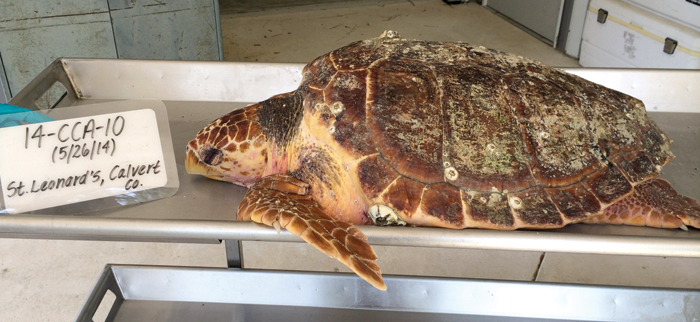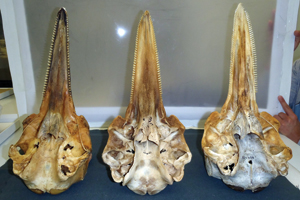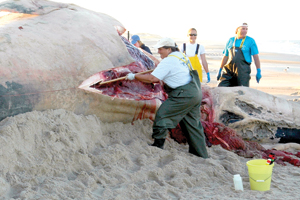Game of Bones: Investigating the lives of marine animals

Fresh dead loggerhead turtle; department photos
A large crowd enjoys a hot day on the beach. A small family strolls down to the shore. A group of friends prepares for a day of fishing and boating bliss. All of a sudden something washes ashore. It’s the stuff of evening news headlines and social media click-bait. But for the department’s Marine Mammal and Sea Turtle Stranding Response Program, it’s just another day at the office.
Department personnel respond to an average of 40 strandings each year. In the program’s 26-year history, that includes over 440 marine mammals representing 25 species and over 600 sea turtles from four species. This includes numerous threatened and endangered species such as humpback and North Atlantic right whales as well as loggerhead, Kemp’s ridley and leatherback sea turtles.

Smithsonian dolphin skulls
The experts
The department’s Stranding Response Program handles the creatures that have died. The National Aquarium in Baltimore responds to all live strandings. Between the two, they respond to all strandings along Maryland’s portions of the Chesapeake Bay and Atlantic coast—a combined total of approximately 3,800 miles of coastline.
The Smithsonian Institution aids in the examination of large whales, beaked whales and other uncommon species, as well as preserves skeletal specimens. Staff does not conduct stranding response on their own, but they do provide support to the other two teams as needed.

Cindy Driscoll performing a necropsy
The investigation
Strandings provide an opportunity to study marine mammal and sea turtle biology and health.
In fact, the existence of some species is known only as a result of response and data collection. Specifically, data provides information on growth rates, maturity age, reproductive season, illnesses and mortality causes. Marine mammals and sea turtles serve an incredibly important role, acting as indicator species to the overall health of our waters.
A typical stranding response involves collecting basic information such as carcass condition, location, measurements and sex determination. Externally, animals are photographed and examined for parasites, tags and signs of injury or trauma.

Weschler leading a dolphin necropsy
They are evaluated for evidence of human interaction, including boat or ship strikes, bullet wounds, dorsal fin or fluke removal, entanglement in fishing gear or plastic ingestion. In order to maximize the scientific potential of stranded animals, data and specimens must be collected in a standardized, systematic way on the greatest possible number of specimens over a long period of time.
Stranding response also involves collecting more detailed information, which is collected via necropsy. These systematic internal exams are conducted to analyze each organ and evaluate stomach contents for feeding activity and prey composition.
Samples are then collected for a variety of diagnostic tests including: histology, microbiology, parasitology, toxicology and virology.
|
Letting them be
The federal government protects all species of marine mammals and marine turtles. The Marine Mammal Protection Act of 1972 prohibits the harassment, hunting, capture and killing or the attempt thereof, as well as approaching, feeding, petting or trying to swim with them. It also bans the importation of marine mammal products to the U.S. The Endangered Species Act of 1973 further protects both threatened and endangered species of marine mammals and sea turtles. These animals should be admired from a distance, for the safety of both the animals themselves and the general public.
How you can help
If you see a stranded marine mammal or sea turtle, dead or alive, please call the 24-hour hotline at 800-628-9944. Try to:
- Identify the species. If you aren’t sure, note the color, head shape, dorsal fin shape, shell size or any other defining characteristic.
- Estimate its size.
- Gauge the animal’s condition: alive, newly dead, moderately decomposed, decidedly decomposition or skeletal remains.
- Look for obvious signs of human interaction: entangled in fishing gear or mutilation.
- Note any unusual environmental conditions: increase in commercial fishing activity, dredging, bad weather, algal blooms or abundance of other dead species.
- Most importantly, please take photos. Providing documentation is the most accurate way for stranding response personnel to accurately evaluate the situation.
Did you know?
|
Article by Cindy Driscoll, D.V.M.—state fish and wildlife veterinarian and Stranding Response Program founder and Amanda Weschler—biologist and Marine Mammal and Sea Turtle Stranding coordinator.
Appears in Vol. 19, No. 4 of the Maryland Natural Resource magazine, fall 2016.

http://shopdnr.com/dnrmagazine.aspx
